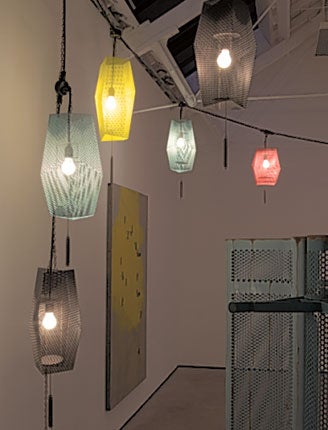Martin Boyce, Modern Institute, Glasgow

A neglected park in a down-at-heel seaside resort, where teenagers spend winter up-ending the benches. Turner-shortlisted Martin Boyce often recreates a plangent corner of the outside world within a gallery, playing with the built environment, resetting it in a minor key.
So the skylights along the roof of the Modern Institute, a converted wash house on the eastern fringe of Glasgow's city centre, have been shaded over, to create a permanent dusk. Illumination comes from a chain of lanterns suspended from the walls. Three concrete panels need a sliver more natural light, but the rest of the space is all evocative gloom.
The lanterns are a new departure for Glaswegian Boyce, who is fixated with Modernism and reworks favourite themes and references over and over. Made of finely perforated steel, in off-centre shades of turquoise, lime and red reminiscent of dockside storage units, each one is slightly different. Four times the size of the twinkling paper lanterns they allude to, they are constructed from the geometric shapes that recur throughout his work.
Understand these and everything, from the niggling hieroglyphics on his panels to a dangling mobile on his library table, becomes clear. Boyce has an ongoing obsession with four concrete trees designed by French twins Joël and Jan Martel for the Exposition des Arts Décoratifs et Industriels Modernes in Paris in 1925. These Cubist marvels strip the tree down to its barest planes and angles, and Boyce revisits these core shapes in almost every piece he produces.
Each facet of a lantern is a version of the Martels' asymmetric leaf. Each plays a different optical trick. In some, the tiny holes in the metal form squares of dancing dots. In others the pattern moves up and down in a V-formation, like an animated Missoni cardigan. Just a tiny movement of the head makes them pulse.
On the floor below, The Waves is familiar Boyce territory, four grotty metal benches arranged into a rolling formation. The forgotten sea of the show's title, it takes the kind of seat where a visitor might rest and enjoy the salty breeze, turns it on its side and hides its prosaic nature.
Beside it sits a version of the library table from the Zurich show which so impressed the Turner judges. That one was black, this one is made from weathered, mottled galvanised steel. Based on French architectural designer Jean Prouvé's mid-century scholastic furniture, it appears to have been graffitied (in Boyce's weird Martel-based typeface) then abandoned to rot. Nearby, one of his squinty leaf-based bins has an ancient hoodie inside, presumably left by one of the library's transient users. Three mysterious Jesmonite panels, deliberately distressed and with more of the higgledy-piggledy Martel symbols, complete the show.
What impresses most is that, although Boyce's core-piling obsession with modernism informs every single element in the room, it is completely optional. The viewer can enjoy the mood, the visual effects of the lanterns, the play of inside with outside, while knowing nothing of the Martel twins and their concrete copse. The air of melancholy and abandonment, the smell of old classroom and boarded-up seafront is quite separate from the rigorous academic process of its creation. And all the more moving for it.
To 25 June (0141 248 3711)
Subscribe to Independent Premium to bookmark this article
Want to bookmark your favourite articles and stories to read or reference later? Start your Independent Premium subscription today.

Join our commenting forum
Join thought-provoking conversations, follow other Independent readers and see their replies